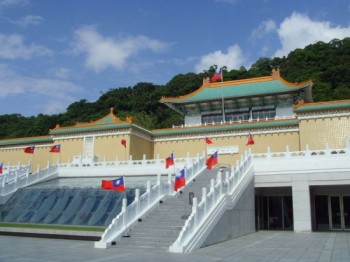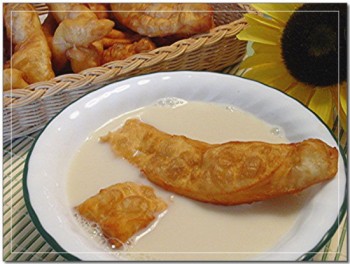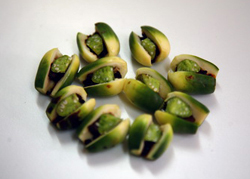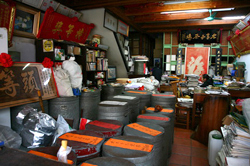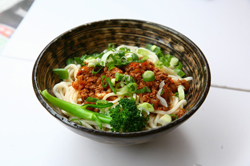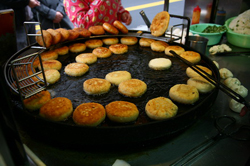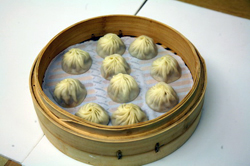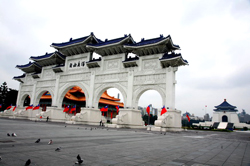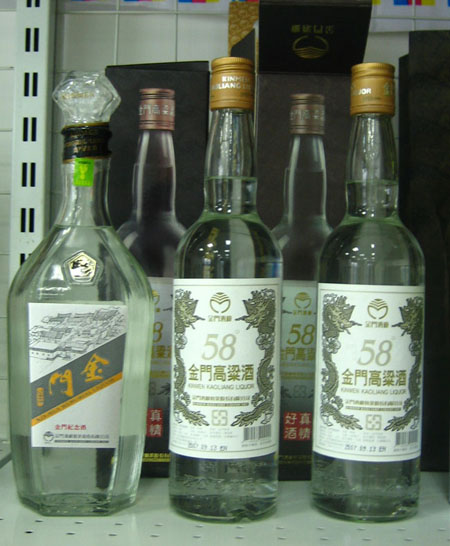(单词翻译:单击)
概述
Citywalk: Taipei
Taipei boasts a wide variety of scrumptious, regional Chinese cuisines and a few down-home specialties, all of which stem from the island's history.
Take one part local food tradition, which shares much with southeastern Chinese fare and favors fresh seafood, especially oysters. Add a strong dash of Japanese flavor (like wasabi), culled from 50 years of Japanese colonization that ended in 1945. Then mix in some of China's finest cooking traditions from Chongqing to Shenyang (think Sichuan-style gong bao ji ding -- kungpao chicken -- and northern China-style beef noodle soup) brought here by the Mandarin-speaking Kuomintang elite when they fled the mainland, along with their cooks, in the late 1940s. The result: contemporary Taiwanese food.
For a city with a reputation among some foodies for having some of the world's best Chinese food, an eating tour of Taipei is highly appropriate. But it's not for the faint of heart, or small of stomach.
In fact, were you to actually consume all the food and drink on this itinerary, you'd feel more like a nap than a walk. Consider yourself warned: Nibble at the suggested stops, don't fill up. And pick and choose dishes according to your taste, appetite and endurance.
台北以各式中国地方美味和众多特色家常小吃而闻名,而所有这一切都与台湾岛的历史分不开。
首先,选取一部分当地的饮食传统:台北饮食与中国大陆东南地区的食品有很多共同点,比如偏爱新鲜的海味,特别是牡蛎。接下来,再加上一抹浓郁的日式风味(比如绿芥末):这是日本在1945年以前占领台湾50年所遗留下的痕迹。最后,融入中国从重庆到沈阳的那些最优良的烹饪传统:这是二十世纪40年代后期由国民党高官,以及他们的厨师,从大陆带来的(想想川菜中的宫保鸡丁和中国北方的牛肉面)。“当代台湾饮食”就此出炉。
在一些美食家看来,台北拥有世界上最好吃的中餐,所以到台北展开一次美食之旅实在是再合适不过了。但是对于胆子小,抑或是胃口小的游客来说,则要另当别论了。
实际上,当你真正开始按照以下行程品尝过台北美食以后,你会觉得这更像是做了个美梦,而不像是走过一段旅途。要注意:在我们推荐的每一站好去处只可少量品尝,千万别吃饱,而且还要根据自己的口味、胃口和耐力来挑选要品尝的食物。
豆浆油条
9 A.M. DOUJIANG AND YOUTIAO
For breakfast, start your stroll at the Taipei Fullerton, a boutique hotel on Fuxing South Road. From the hotel, turn left and cross Fuxing South Road. Soon, you'll hit a small strip of doujiang (soy milk) restaurants.
Head for the first one on the corner: Yonghe Doujiang Da Wang (Yonghe Soy Milk Emperor) at No. 102, next to a fire station. It takes its name from the suburb, Yonghe, where the original restaurant was located. Today, Yonghe-style breakfast joints are famous across the Chinese-speaking world.
The quintessential Yonghe-style breakfast is doujiang and youtiao -- soy milk and fried bread sticks. The soy milk comes cold or hot, spooned up from big vats near the entrance. If you want a more substantial breakfast, add the turnip cake with soy-based sauce (luo buo gao), a pancake-and-egg combo (shao bing jia dan), and crisp cakes (su bing), lightly baked, hollow thin cakes with sugar, sesame or peanut paste spread on the inside. You should be able to walk away with a full stomach for well under US$3.
上午9点:豆浆油条
首先去吃早饭:我们从台北市复兴南路上的馥敦饭店出发。出了饭店往左拐,穿过复兴南路,很快你就会走到豆浆一条街。
直奔拐角处的第一家:紧邻消防队的102号──永和豆浆大王。豆浆店的名称来源于“永和县”这个地名,最早的永和豆浆店就开在那里。如今,永和风格的早餐连锁店已经在华人世界声名远播。
永和早餐的精髓就是豆浆和油条。豆浆装在一进门的大容器中,既可冷喝也能热饮。如果你想要吃一顿更丰盛的早餐,还可以再来一块萝卜糕、烧饼夹蛋或者是酥饼。只要花上不到3美元,你就能够吃得饱饱的。
安东市场
10 A.M. AN DONG MARKET
From the breakfast place, turn right and continue south down Fuxing South Road. Take a right on Lane 148, Fuxing South Road (Taipei's side lanes are named after the roads they branch off).
Check out the betel-nut stand near the corner, and try some if you dare. This mild intoxicant is a favorite in Taiwan, India and some parts of Southeast Asia (but not mainland China). Working-class types here swear by the stuff, and you can tell a betel-nut fan by the telltale red stains around the mouth.
Across Taiwan, especially outside major cities, 'betel nut beauties' -- 20-something females in microscopic outfits -- attempt to lure buyers to their roadside stands. But in Taipei, you're more likely to find a cranky middle-aged man or smiling granny selling the nuts. If you try it, bite or clip off the rind of the nut, then chew it like gum -- don't swallow it and be sure to spit out the juice, otherwise you're likely to get sick to your stomach. A small bag of nuts costs $1.50.
Continue walking down Lane 148 until you reach the An Dong market on your left, at No. 75 Rui An St. Here's your chance to check out a traditional Taiwanese market. Many are losing business to supermarkets, but they aren't extinct yet. Check out the butcher and the fruit stands. You'll also find shops selling 'ghost money,' paper that's burned for good fortune and to appease the gods or wandering spirits.
Leave the market and cut across Rui An Street to Lane 180, Rui An Street. There's an old-fashioned tea shop called Lao Ji Zi on your right, at No. 5 Lane 180. This is run by the Tseng family, who own tea fields in Taiwan and on the mainland.
Big metal canisters store their crop: oolong tea picked from Alishan, gaoshan (high mountain) tea from Nantou County, and some much-prized puer tea, picked from trees in China's Yunnan province. The half-jin (500-gram) tins of tea make great gifts; a basic oolong costs $9, a tin of the gaoshan variety costs about $60. Say hello to Mrs. Tseng, who runs the shop while her husband tends to the fields in central Taiwan.
上午10点:安东市场
从永和豆浆店出来,往右拐,一直往南沿着复兴南路走。到了复兴南路148巷(台北的巷子名前面都要加上主路的名字)再往右拐。
如果你够胆量,就试试角落里的那家槟榔摊。槟榔在台湾、印度以及东南亚的其他一些地方(但不包括中国大陆)深受大众喜爱。这里的劳动阶层对槟榔十分锺情,而且从红红的嘴巴你就能很容易分辨出谁是槟榔爱好者。
在整个台湾,尤其是大城市周围,“槟榔西施”──指那些穿着暴露的20多岁的年轻女孩──会想办法把买主们吸引到她们的摊位前。但是在台北,向你兜售槟榔的更有可能是一个看起来有些古怪的中年男人或者满面笑容的老奶奶。如果你愿意尝尝的话,要先咬掉或者剪掉槟榔壳,然后像嚼口香糖一样咀嚼槟榔。别咽下去,而且一定要把槟榔汁吐出来,要不然你的胃可能会不舒服。一小袋槟榔的价格是1.5美元。
继续沿着148巷向前走,你会看到左手边瑞安街75号的安东市场。在这里,你可以一睹台湾传统市场的风采。虽然许多商铺的生意都被超市抢去了,但这里的商铺还没有被完全挤垮。你可以到生肉和水果摊位去看看。你还会看到一些卖“冥币”的商铺,人们烧纸钱是为了祈求好运,告慰神灵。
从市场出来,穿过瑞安街到瑞安街180巷,在右手边的180巷5号你会看到一家名为“老吉子”的茶行。茶行老板姓曾,在台湾和大陆都有茶田。
大大的金属罐子里存放着茶叶:这里有从阿里山采摘的乌龙茶、从南投县采摘的高山茶以及一些来自中国云南省的备受赞誉的普洱茶。买半斤(500克)茶叶作为礼物送人是个很不错的选择。一盒普通乌龙茶的价格为9美元,一盒高山茶的价格为60美元。别忘了和曾太太打个招呼,在丈夫照看位于台湾中部的茶田时,她就会帮忙经营店铺。
大安公园
12 P.M. DA AN PARK
Lunch time. As you leave the tea shop, turn right and continue west on Lane 180, Rui An Street, which turns into Lane 151, Jianguo South Road.
The restaurant at No. 53 Lane 151 on your right is Mei Xiang La Mian Wu (open 12 p.m. to 2 p.m. for lunch, and 5 p.m. to 8 p.m. for dinner). Order the 'clerk's pulled noodles' (xiao er lao mian in Mandarin), a light Chinese-style lunch. You'll get a pile of noodles with a generous dollop of minced beef in sauce, garnished with scallions and cilantro. Mix up the noodles and sauce before eating, then slurp away. This northern Chinese dish was popularized here by mainlanders who came in the late 1940s. A big bowl will cost you $2.20; a small bowl, $1.75.
After lunch, take a long walk through Da An Park. This 26-hectare patch of green is Taipei's answer to New York City's Central Park. On weekends, it's packed with rollerblading kids, dog-crazy Taipei urbanites walking their canines and bicyclists.
You'll enter on the east side of the park across from a public library. Make your way through to the southwest corner of the park -- you can take the shaded jogging path on your left, which runs along the edge of the entire park. The exit is across from a Sizzler steak house.
From the park exit, cross Xinsheng South Road, take a left and follow the road south. You'll come to the Wistaria Tea House (No. 1, Lane 16). This famous Taipei teahouse has recently re-opened after a long renovation.
Back in the days of martial law (1949 to 1987), democracy activists gathered here over pots of oolong tea to strategize. Now, it's an obligatory stop for local tea-lovers. The shop boasts a wide variety of Taiwan- and mainland-grown teas, served in a cozy, Japanese colonial-era setting, with low tables, tatami mats and partitions, as well as a no-shoe policy in some rooms.
Try the Bai Hao or 'Oriental Beauty' oolong ($9) -- grown with the help of katydid (an insect related to a grasshopper) saliva. (The tea tastes better than it sounds.) Or have a sip of some Dong Ding oolong ($8) grown in central Taiwan. Show-offs can shell out $90 for the 'Dragon and Horse Tong Qing Puer,' a 1920s-vintage puer tea.
中午12点:大安公园
午餐时间到了。从茶行出来,向右拐,继续沿着瑞安街180巷往西走,就到了建国南路151巷。
右手边的151巷53号是一家名为“美香拉面屋”的餐馆(午餐中午12点至下午2点提供,晚餐下午5点至晚上8点提供)。点“小二拉面”,品尝一下简单的中式午餐。你会吃到一大碗拉面,很大份量的牛肉酱,上面还撒着大葱和香菜。吃前先把面条和肉酱拌匀,然后一扫而光。这道北方面食是在二十世纪40年代末因为来到此地的大陆人而风行开来的。大碗的价格是2.2美元,小碗的价格是1.75美元。
午餐后,你可以在大安森林公园里散散步。这片占地26公顷的绿地是纽约中央公园的台北翻版。周末的时候,你会看到孩子们在公园里滑旱冰,热衷养狗的台北人溜狗,还有骑自行车的人,熙熙攘攘,好不热闹。
从东门进入大安公园后(入口的对面是一家公共图书馆),往公园的西南角走──你可以沿着左手边树荫遮蔽的慢跑小道步行,这条小道环绕公园一周。出口的正对面是一家“时时乐”(Sizzler)牛排馆。
从公园出来,穿过新生南路,再往左拐,一直往南走,便会来到紫藤庐茶馆(门牌号为16巷1号)。这家知名的台北茶馆在经过长时间的重新装修后最近刚刚开张。
早在台北实施戒严时期(1949年至1987年),民主运动人士会在这里聚集,要上几壶乌龙茶,制定他们的行动计划。现在,这家茶馆成了当地爱茶人士们必去的地方。你可以在这里品尝到在台湾和大陆种植的各式茶叶。紫藤庐茶馆不仅环境舒适,还保留有日本殖民时代的布局,低矮的桌子、榻榻米,还有小隔间。有些房间还不允许穿鞋。
试试又名“东方美人”茶的白毫(9美元)──这种茶叶是在蝉虫的叮咬吸食下生长起来的。(这听上去让人却步,但这种茶喝起来还不错)。要么呷一口台湾中部种植的冻顶乌龙茶(8美元)。爱摆谱的人可以花上90美元买一块上世纪20年代的陈年普洱茶──“龙马同庆普洱茶”。
小吃
2:30 P.M. XIAO CHI STANDS
Heading west -- take a right as you exit Wistaria -- you'll hit two of this area's most popular xiao chi stands, or street-food stalls. Both usually have long lines, so bring a friend, a book or a lot of patience. (If you don't want to taste these foods here, there are clean, well-lighted restaurants later on in the walk.)
First, try the turnip cake at the stand at the corner of Heping East Road and Wenzhou Street (closed Sundays). One cake costs 75 U.S. cents. Taipei foodies swear by this stuff, and are willing to wait in nerve-straining lines to get their fix.
Next, order the pan-fried dumplings in the Shida Night Market -- it's called a night market, but food is served from the early afternoon through to the wee hours of the morning. Weave your way over to Longquan Street, and look for Xu Ji Sheng Jian Bao at No. 24, a food stall famous for this kind of dumpling. You can try just one for 20 cents, but most people buy five for 90 cents.
Exit the Shida market and backtrack your way north on Longquan Street -- you'll hit Yongkang Street after a leisurely 20-minute walk. This street boasts typical Taiwanese xiao chi, but in nicer surroundings than a typical night market.
Hao Ji Mei Shi Zhuan Mai Dian, on the west side of the street (No. 1, Lane 10), serves southern Taiwanese xiao chi -- local favorites include tu tuo yu gen, a hearty soup with chewy, breaded lumps of fish, and crispy oysters with pepper (in the local Taiwanese dialect, Minnan, this dish is called oasu; in Mandarin, it's ke zi su). A small bowl of the soup costs $1.50 and a small dish of oasu runs $3.
Heading north on the same side of Yongkang Street, you'll hit the restaurant Yongkang Kou (No. 1, Lane 6). Here, if you dare, sample two of Taiwan's most famous dishes, stinky tofu or chou doufu ($1.30) for a small serving), which lives up to its name, and oysters in a broth with vermicelli-like noodles (oamisua in Taiwanese, $1.15 for a small bowl; $1.60 for a large one).
Now, cross to the other side of Yongkang Street, turn left (north), and look for Tu Hsiao Yueh (No. 9-1 Yongkang St.).
Here you can sample southern Taiwanese-style minced pork noodles (danzi mian), either dry or in soup. A small serving costs $1.50. Wash down your noodles with the island's standby brew, Taiwan Beer ('Taiwan pijiu' or 'Taipi' for short); one bottle costs $2.65.
下午2点半:小吃
从紫藤庐茶馆出来向右拐,也就是径直向西走,你会看到这一地区最受欢迎的两家小吃摊。通常情况下,两家店门口都会排起长队,所以最好带上个朋友,或者一本书,要么就要有足够的耐心(如果你不想尝试这里的食物,再往前走,我们待会儿还会去几家干净卫生、宽敞明亮的餐厅)。
首先,在和平东路和温州街拐角的那家店尝尝他们的萝卜糕(星期日不开门)。一块萝卜糕的价格是75美分。台北的食客们很喜欢吃这玩意,宁愿去排令人头疼的长队,也要满足自己的口腹之欲。
接着,在师大夜市点一份锅贴。这里虽然叫做夜市,但是从午后到凌晨一直都在营业。穿过拥挤的人群走到龙泉街,找到24号因为生煎包而闻名的“许记生煎包”。你可以花20美分买一个尝尝,但是大多数人一般都会花90美分买五个。
从师大夜市出来,沿着龙泉街向北往回走,慢行20分钟后,你会走到永康街。这条街因有传统的台湾小吃而颇有名气,而且这里的环境要比传统的夜市好一些。
在永康街路西(10巷1号),有一家“郝记美食专卖店”(音),在这里可以吃到台湾南部的小吃。当地人最喜欢的小吃中包括土?鱼羹──醇厚料足的羹汤,配上炸过的鱼块,以及蚵仔酥──煎炸过的脆脆的牡蛎,再配上胡椒。小碗土 鱼羹的价格是1.5美元,而小碗蚵仔酥的价格为3美元。
沿着永康街西侧往北走,你会看到“永康口”饭店(6巷1号)。如果你够胆量,可以在这里尝尝台湾最有名的两种小吃,臭豆腐(一小块儿1.3美元)──味道也名符其实和蚵仔面线(1.15美元一小碗,1.6美元一大碗)。
现在,到永康街的另一侧,向左拐(往北走),去找一家名为“度小月”的饭店(永康街9-1号)。
在这里,你可以品尝一下台南风味的担仔面,分干面和汤面两种。一小碗的价格是1.5美元。一边吃着面条,一边还可以喝着本地产的台湾啤酒(简称“台啤”),一瓶台啤的价格是2.65美元。
鼎泰丰
5 P.M. DIN TAI FUNG
No culinary tour in Taipei would be complete without a stop at the restaurant Din Tai Fung for a taste of its Shanghai-style pork-soup dumplings (xiao long bao), served with sliced ginger and soy sauce.
Guidebooks swear by them; food snobs say they're overrated. Decide for yourself. One serving costs $5.30 and includes 10 dumplings.
To get there, continue north on Yongkang Street from the stinky-tofu joint, then hang a right on Xinyi Road. Just a few doors down is the original location of this now-famous chain restaurant (No. 194 Xinyi Rd., Section 2). Be warned, though: Hordes of tourist groups mob this place at peak mealtimes, so be prepared for a wait. Of course, you may need time to digest the other snacks you've just had.
下午5点:鼎泰丰
如果不去鼎泰丰,那么台北美食之旅就不算完整。在那里,你可以吃到上海风味的小笼包,搭配有姜片和酱油。
旅行指南上一定会提到这里的包子,那些所谓的美食专家认为这家店名过其实了。你自己决定吧。一份小笼包有10个,价格是5.3美元。
从臭豆腐连锁店出来,继续沿着永康街往北走,然后向右拐到信义路,再往前走几步就会看到“鼎泰丰”这家知名连锁店的旧店(信义路二段194号)。但是,要记住,每到用餐高峰时间,成群的旅游团会蜂拥的这里,所以你一定要做好等待的准备。当然啦,你也可能需要时间来消化刚刚吃下去的其他小吃。
国立中正纪念堂
6 P.M. NATIONAL CHIANG KAI-SHEK MEMORIAL HALL
Finish your tour with a brisk 15-minute walk west down Xinyi Road to the National Chiang Kai-shek Memorial Hall. This monument to the dead autocrat (he ruled Taiwan from 1949 to his death in 1975), which opened in 1980 in a sprawling 25-hectare plaza, includes a grand concert hall at the other end of the square. It's best viewed at night, when it's illuminated by ground lights, and groups of middle-aged Taiwanese come to line dance to U.S. country-and-western songs on the plaza.
After a good rest and a break from eating, try Taiwan's famous pearl, or 'bubble' milk tea -- a shaved ice-and-tea confection served with tapioca balls and jumbo-size straws. The place to get it is Chun Shui Tang, the central-Taiwan store that invented it in late 1980s, and there's a branch in the ground floor of the National Concert Hall on the north side of the memorial plaza (the shop closes at 8:30 p.m.). A small glass costs $2.20; a large glass that's big enough for two costs $4.40.
下午6点:国立中正纪念堂
沿着信义路往西走15分钟,就到了国立中正纪念堂,这里也是我们的最后一站。这座纪念堂是为了纪念蒋介石这位已逝的台湾独裁者(他从1949年开始统治台湾,直到1975年去世)而兴建的,1980年对公众开放,加上广场另一端的大型音乐厅,占地共25公顷。最好的观景时间是在晚上,那时整个纪念堂由地灯照明,成群结队的台湾中年人会在广场上随着美国乡村和西部歌曲翩翩起舞。
养足精神之后,你应该去试试台湾著名的珍珠奶茶──刨冰和茶的混合物,里面还有粉圆,需要用大号的吸管饮用。喝珍珠奶茶的地方叫作“春水堂”。春水堂起源于台湾中部,二十世纪80年代末这家店发明了珍珠奶茶。在中正纪念堂广场北边的国家音乐厅底下,春水堂有一家分店(晚上8点半关门)。一小杯珍珠奶茶的价格是2.2美元,足够两人喝的大杯要花上4.4美元。
金门高粱酒
6:50 P.M. KINMEN KAOLIANG LIQUOR
If you can make it in time, run by the Kinmen Kaoliang Liquor store, a short walk from the Memorial Hall plaza's southwest corner (No. 3, Roosevelt Rd., Section 1; open to 7 p.m. weekdays and Saturdays).
Sample the shop's famous Taiwanese sorghum liquor -- a fiery concoction brewed on Kinmen (also known as Quemoy, a small island in the Taiwan Strait controlled by Taiwan) -- and take a gift bottle with you. There's a variety of sizes and strengths -- choose between 28-, 30-, 38- and 58-proof. You can taste a few for free before you decide, but most people opt for the high-test 58-proof variety ($15.60 for a 750-milliliter bottle).
Assuming you can still fit in a taxi, hop in one here to return to your hotel.
下午6:50:金门高粱酒
如果你还有时间,就去一趟金门高粱酒商店,从纪念堂广场的西南角走不远便到(罗斯福路一段3号,工作日和星期六营业到晚上7点)。
尝尝店里有名的台湾高粱酒──金门岛上酿造的烈酒(地处台湾海峡、属台湾管辖的小岛)──再买一瓶作为礼物送人。这里有各种容量和酒精浓度的酒供你选择。酒精浓度有28度、30度、38度和58度的。你可以免费品尝,不过大多数人会选择58度的高度酒(一瓶750毫升的高粱酒售价为15.6美元)。
假使你还能坐进出租车的话,就在这里搭车返回酒店吧。

